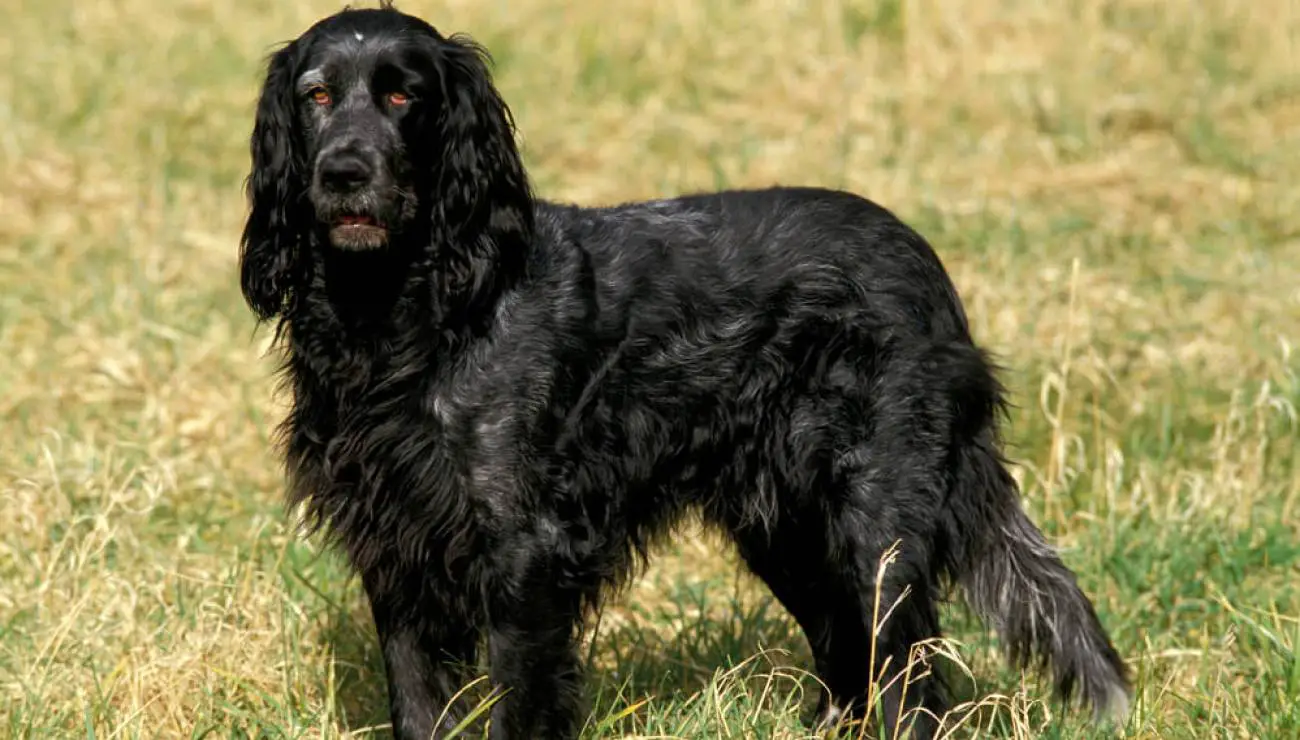Blue Picardy Spaniel
Blue Picardy Spaniel is a spaniel dog breed originating in France. This dog descended from Picardy Spaniels and English Setters. Originally, these dogs were used for flushing and retrieving birds. They are known for their beautiful blue coat.
This sweet, gentle, and loveable dog fits great into the companion role. Blue Picardy Spaniel is not widely popular, and most of these dogs can be found in France and Canada.
FUN FACT: These dogs are also known as Épagneul Bleu de Picardie.

Height:
22-24 in (56-60 cm)

Weight:
44-59 lb (20-27 kg)

Origin:
France

Life Expectancy:
12-14 years
Dog Breed Characteristics
Appearance
The Blue Picardy Spaniel is characterized by the breed standard as "designed for work." A slender and athletic body with no overly pronounced features is ideal for this role. They have large heads, long muzzles, and drooping lips. They should track scent better thanks to their broad nostrils and huge, black noses. Their eyes, which are dark in color, exhibit a soft and peaceful look. Pendulous ears are long and coated in fine, silky fur.
Temperament
The Blue Picardy Spaniel is a versatile hunting dog capable of tracking, pointing game, and retrieving. Still, they are also friendly and loyal dogs with a peaceful and polite disposition. These dogs typically love other dogs and people, and they form strong bonds with their families. However, their eagerness and high hunting drive can make smaller animals easy prey for them.
Care guide
The Blue Picardy Spaniel might be a working breed, but most dogs took a new role as beloved family pets. That means these breed's needs have changed. The best thing you can do for your dog is to talk to your vet and make sure you're taking care of them properly. Here are the most essential parts of the Blue Picardy Spaniel care.
Grooming
Keeping this dog looking good, smelling nice, and tangle-free requires only light to moderate care. While some Blue Picardy Spaniels can get away with a bath every three months, others might require one every month, depending on the time they spend outside and in the mud.
Moderate shedding can be controlled by brushing a couple of times a week. Still, when the shedding season starts, you will need to brush them more often to control the hairy mess they can leave behind.
Because the toes of the feet are tight and they have hair that grows between them, you should keep an eye on the dog’s paws. Sometimes, that hair gets tangled, and if it isn't taken care of right away, tangles can cause skin issues. Make sure the dog’s ears are clean. Look for signs of infections like redness, discharge, or bad odor. You can use ear cleaners to keep their ears in perfect condition.
Training
A Blue Picardy Spaniel is an easy dog to train due to its adaptable personality and eagerness to please. As you can imagine, training these dogs for hunting is pretty easy.
It's no surprise that this breed is a popular choice for dog sports like agility, flyball, and other obedience competitions.
Exercise needs
The Blue Picardy Spaniel needs at least 60 minutes of daily exercise because it is an active breed. They can be a fantastic jogging buddy, or going on a lengthy hike with them is not a problem. Playing fetch or chasing toys with people they love is one of these dogs' favorite activities.
The Blue Picardy Spaniel is prone to boredom and may even act out without enough exercise. Hyperactivity and furniture destruction at home are among the most common symptoms of an unhappy and unfulfilled dog. An understimulated dog will behave like that. Owners need to understand that their pet is not being naughty; it's simply looking for a way to entertain itself and spend the excess energy.
Socialization
Blue Picardy Spaniel, in most cases, is a joy to socialize. They are naturally friendly, but that doesn't mean you should skip socialization. If you decide to go for one of these dogs, the whole process of socialization is a lot easier. As soon as your Picardy puppy comes home, you should introduce them to various sights, sounds, smells, people, and dogs (once the puppy is fully vaccinated).
Failing to do so can result in shy dogs, which is not something you want for your dog.
Blue Picardy Spaniels and kids
Those with an active lifestyle will enjoy having a Blue Picardy Spaniel as a pet. Despite their natural predisposition to hunting, these dogs rarely bite or show signs of aggression. They have a voracious appetite for physical activity and require it daily. Picardys are typically kid-friendly.
Some roughhousing is no problem for them. They can also play for hours since the Blue Picardy is so energizing.
After a hard day, the Blue Picardy enjoys curling up with their family to relax and recharge their batteries. They develop close relationships with their families and like spending time with them. Blue Picardys make great pets for families that like to get out and explore nature on hikes.
Blue Picardy Spaniels and pets
Blue Picardy dogs are much more than just hunter's dogs. Spaniels are pointers and retrievers, meaning they weren't bred for attacking prey. For this reason, they usually get along great with a wide range of animals. As with most dogs, they should be exposed to other pets, like cats, early on so that they become accustomed to sharing their space with them.
With other dogs, they are also generally friendly. When it comes to other pets and these dogs, the only thing to watch out for is birds. These dogs probably won't lunge at the bird, but their pointing and retrieving instincts will be triggered by the presence of birds in the house. You don't want them barking all the time.
Health
The Blue Picardy Spaniel has a lifespan of 12 to 14 years because of its working history and because breeders have not exaggerated their traits (less inbreeding). Since the Blue Picardy Spaniel is relatively young, all discussion about its health is based on owner and vet experiences and comparisons to similar breeds.
Unfortunately, the lack of health studies leaves us with a gap in our knowledge about the health of these dogs. All future Blue Picardy Spaniel owners should keep an eye on these health conditions;
- Ear infections - These dogs' ears are floppy, so they don't get as much air circulation as some other breeds might. It is best to keep an eye on infection signs.
- Hip dysplasia - Genes play a role in this illness, but it can also be brought on by developmental issues and trauma. It is an incorrect hip joint formation.
- Ectropion - Eyelids roll outward, causing the dog's vision to be affected.
Blue Picardy Spaniel breeders
If you're looking to get a dog, you should contact a reputable breeder, no matter which breed you're looking for. In this case, you should look for a Blue Picardy Spaniel breeder with excellent breeding practices and a great reputation. When you find them, ask them as many questions about this breed as you can.
We are sure they will gladly tell you everything you need to know and give you great advice about living and caring for a Blue Picardy Spaniel.
World Dog Finder team

Updated at07.09.2023.
Breed History
The Epagneul Bleu de Picardie, also known as the Blue Picardy Spaniel, is a near relative of the Picardy Spaniel, English, and Gordon Setter. Their ancestry can be traced to the 14th-century French Spaniels, hunting dogs that inspired a slew of other breeds.
It was a popular pastime for English hunters to traverse through Picardy in the early 20th century with their dogs, many of which were Blue Belton Setters and other similar British breeds. They were regularly crossbred with local hunting dogs, especially Spaniels because quarantine regulations required these dogs to stay quarantined for months.
Because of its distinctive color, the Blue Picardy Spaniel was named after it. These dogs used to flush out birds so that hunters might catch them. The Blue Picardy Spaniel's ability to hunt alone and with other dogs makes it appealing to hunters who want a dog that can fill multiple roles.
When this breed was first recognized in 1938, it was not considered only a coloration variation of the Picardy Spaniel but an independent breed in its own right. Since 1996, the UKC (United Kennel Club) has recognized them as a member of its gun dog registry.
Even though it is more prevalent in its native country of France, these dogs have recently become more popular in places like the US and Canada. They are beloved for their ability to be good family pets and their working ability.












Share